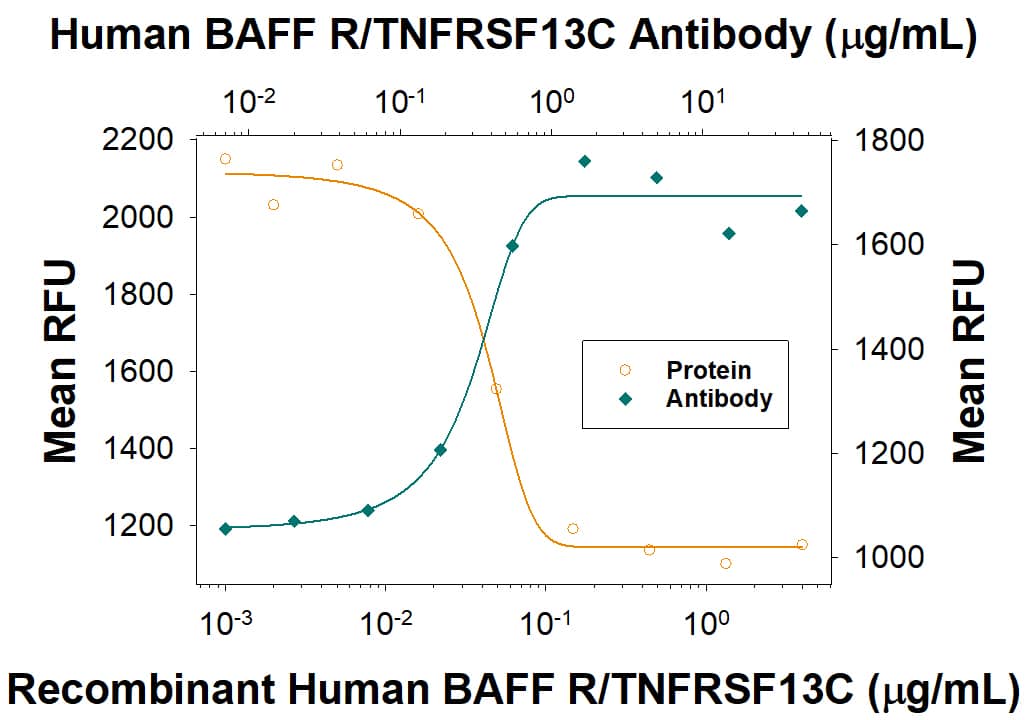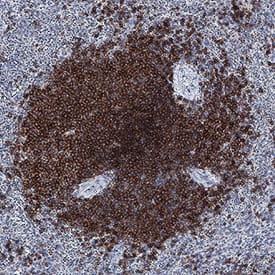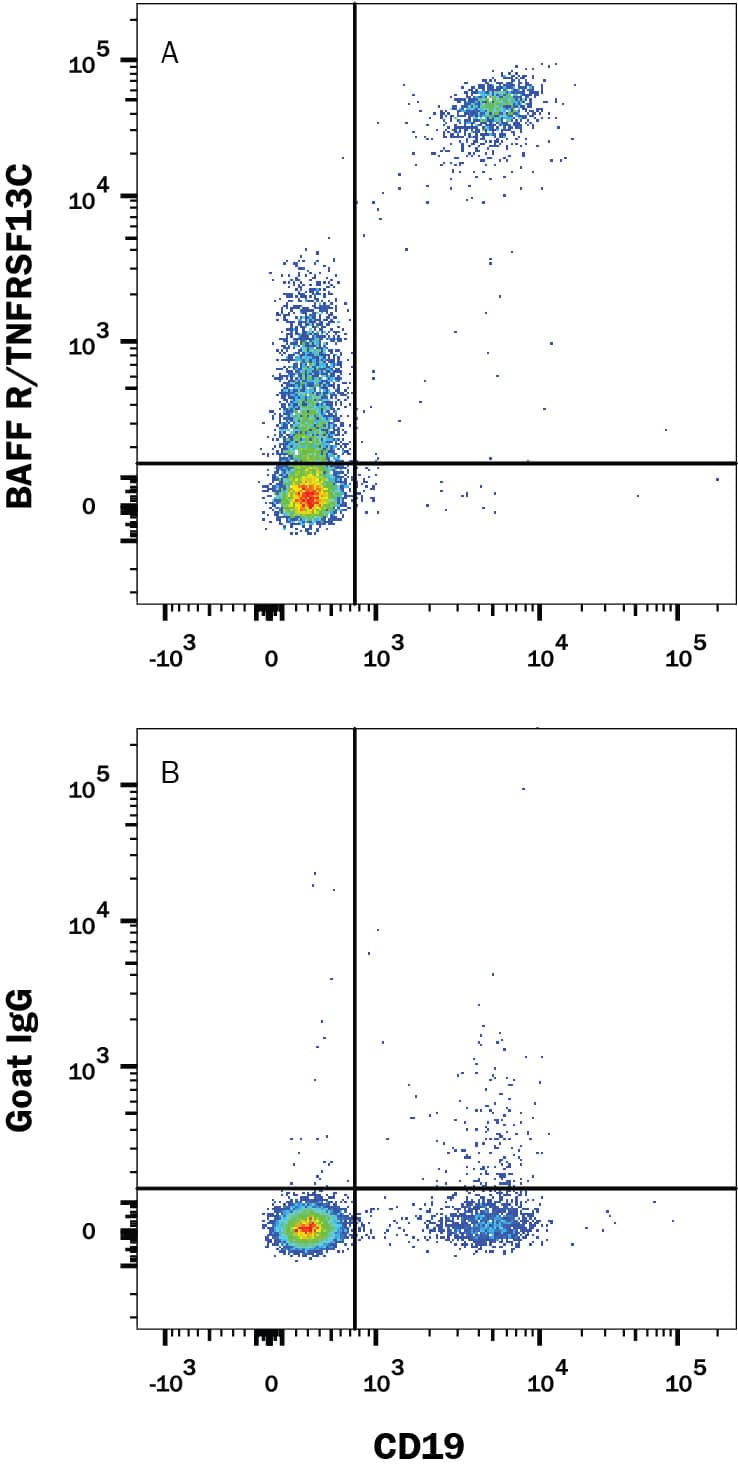Human BAFFR/TNFRSF13C Antibody Summary
Arg2-Ala71
Accession # Q96RJ3
Applications
Please Note: Optimal dilutions should be determined by each laboratory for each application. General Protocols are available in the Technical Information section on our website.
Scientific Data
 View Larger
View Larger
BAFF R/TNFRSF13C Inhibition of BAFF/BLys/ TNFSF13B-dependent Cell Proliferation and Neutralization by Human BAFF R/TNFRSF13C Antibody. Recombinant Human BAFF R/TNFRSF13C Fc Chimera (Catalog # 1162-BR) inhibits Recombinant Human BAFF/BLyS/TNFSF13B (Catalog # 2149-BF) induced proliferation in mouse B cells in a dose-dependent manner (orange line). Inhibition of Recombinant Human BAFF/BLyS/TNFSF13B (5 ng/mL) activity elicited by Recombinant Human BAFF R/TNFRSF13C Fc Chimera (0.3 µg/mL) is neutralized (green line) by increasing concentrations of Goat Anti-Human BAFF R/TNFRSF13C Antigen Affinity-purified Polyclonal Antibody (Catalog # AF1162). The ND50 is typically 0.1-1 µg/mL.
 View Larger
View Larger
BAFF R/TNFRSF13C in Human Spleen. BAFF R/TNFRSF13C was detected in immersion fixed paraffin-embedded sections of human spleen using Goat Anti-Human BAFF R/TNFRSF13C Antigen Affinity-purified Polyclonal Antibody (Catalog # AF1162) at 3 µg/mL for 1 hour at room temperature followed by incubation with the Anti-Goat IgG VisUCyte™ HRP Polymer Antibody (Catalog # VC004). Before incubation with the primary antibody, tissue was subjected to heat-induced epitope retrieval using Antigen Retrieval Reagent-Basic (Catalog # CTS013). Tissue was stained using DAB (brown) and counterstained with hematoxylin (blue). Specific staining was localized to plasma membrane and cytoplasm. View our protocol for IHC Staining with VisUCyte HRP Polymer Detection Reagents.
 View Larger
View Larger
Detection of BAFF R/TNFRSF13C in PBMCs by Flow Cytometry. Peripheral blood mononuclear cells (PBMCs) were stained with Mouse Anti-Human CD19 Fluorescein-conjugated Monoclonal Antibody (Catalog # FAB4867F) and either (A) Goat Anti-Human BAFF R/TNFRSF13C Antigen Affinity-purified Polyclonal Antibody (Catalog # AF1162) or (B) Normal Goat IgG Control (Catalog # AB-108-C) followed by APC-conjugated anti-goat secondary antibody (Catalog # F0108). View our protocol for Staining Membrane-associated Proteins.
Reconstitution Calculator
Preparation and Storage
- 12 months from date of receipt, -20 to -70 °C as supplied.
- 1 month, 2 to 8 °C under sterile conditions after reconstitution.
- 6 months, -20 to -70 °C under sterile conditions after reconstitution.
Background: BAFFR/TNFRSF13C
B cell activating factor (BAFF), also known as BlyS, TALL-1, TNAK, and zTNF4, is a TNF ligand superfamily member and has been designated TNFSF13B. Produced by macrophages, dendritic cells, and T lymphocytes, BAFF promotes the survival of B cells and is essential for B cell maturation (1-4). BAFF binds to three TNF receptor superfamily members: B cell maturation antigen (BCMA/TNFRSF17), transmembrane activator and calcium-modulator and cyclophilin ligand interactor (TACI/TNFRSF13B) and BAFF receptor (BAFF R/BR3/TNFRSF13C). These receptors are type III transmembrane proteins that lack a signal peptide. Whereas TACI and BCMA bind BAFF and another TNF superfamily ligand, APRIL (a proliferation-inducing ligand), BAFF R selectively binds BAFF. The BAFF R extracellular domain lacks the TNF receptor canonical cysteine-rich domain (CRD) and contains only a partial CRD with four cysteine residues. Human and mouse BAFF R share 56% aa sequence identity. BAFF R is highly expressed in spleen, lymph node and resting B cells. It is also expressed at lower levels in activated B cell, in resting CD4+ T cells, in thymus and peripheral blood leukocytes. BAFF knockout mice lack mature B cells. Similarly, A/WySnJ mice that are defective in BAFF-R intracellular signaling also lack mature B cells, suggesting that BAFF R is the critical receptor for BAFF during B lymphopoiesis. In contrast, BCMA- or TACI-deficient mice have no major defect in B cell development. While the function of BCMA is not defined, TACI has been shown to control B cell homeostasis and T cell-independent immune responses.
- Rolink, A.G. and F. Melcher (2002) Curr. Opin. Immunol. 14:266.
- Mackay F. and J.L. Browning (2002) Nature Reviews Immunology 2:464.
- Laabi, Y. et al. (2001) Current Biol. 11:R1013.
- Thompson, J.S. et al. (2001) Science 14:2108.
Product Datasheets
Citations for Human BAFFR/TNFRSF13C Antibody
R&D Systems personnel manually curate a database that contains references using R&D Systems products. The data collected includes not only links to publications in PubMed, but also provides information about sample types, species, and experimental conditions.
14
Citations: Showing 1 - 10
Filter your results:
Filter by:
-
Blockade of B-cell-activating factor suppresses lupus-like syndrome in autoimmune BXSB mice
Authors: Hanlu Ding, Li Wang, Xiongfei Wu, Jun Yan, Yani He, Bing Ni et al.
Journal of Cellular and Molecular Medicine
-
The Role of BAFF-R Signaling in the Growth of Primary Central Nervous System Lymphoma
Authors: Xiaolan Zhou, Matthias Mulazzani, Iven-Alex von Mücke-Heim, Sigrid Langer, Wenlong Zhang, Hellen Ishikawa-Ankerhold et al.
Frontiers in Oncology
-
The BAFF receptor TACI controls IL-10 production by regulatory B cells and CLL B cells.
Authors: Saulep-Easton D, Vincent F, Quah P, Wei A, Ting S, Croce C, Tam C, Mackay F
Leukemia, 2015-07-03;30(1):163-72.
Species: Human
Sample Types: Whole Cells
Applications: Neutralization -
Human B cells induce dendritic cell maturation and favour Th2 polarization by inducing OX-40 ligand.
Authors: Maddur M, Sharma M, Hegde P, Stephen-Victor E, Pulendran B, Kaveri S, Bayry J
Nat Commun, 2014-06-09;5(0):4092.
Species: Human
Sample Types: Whole Cells
Applications: Neutralization -
APRIL Binding to BCMA Activates a JNK2-FOXO3-GADD45 Pathway and Induces a G2/M Cell Growth Arrest in Liver Cells.
Authors: Notas G, Alexaki V, Kampa M, Pelekanou V, Charalampopoulos I, Sabour-Alaoui S, Pediaditakis I, Dessirier V, Gravanis A, Stathopoulos E, Tsapis A, Castanas E
J Immunol, 2012-10-15;189(10):4748-58.
Species: Human
Sample Types: Whole Cells
Applications: ICC -
Fusion Toxin BLyS-Gelonin Inhibits Growth of Malignant Human B Cell Lines In Vitro and In Vivo.
Authors: Luster, Troy A, Mukherjee, Ipsita, Carrell, Jeffrey, Cho, Yun Hee, Gill, Jeffrey, Kelly, Lizbeth, Garcia, Andy, Ward, Christop, Oh, Luke, Ullrich, Stephen, Migone, Thi-Sau, Humphreys, Robin
PLoS ONE, 2012-10-09;7(10):e47361.
Species: Human
Sample Types: Whole Cells
Applications: Neutralization -
BAFF levels are increased in lesional skin and sera in patients with cutaneous T-cell lymphoma.
Authors: Ohmatsu H, Sugaya M, Miyagaki T, Suga H, Fujita H, Asano Y, Tada Y, Kadono T, Sato S
Br. J. Dermatol., 2012-07-05;167(2):359-67.
Species: Human
Sample Types: Whole Tissue
Applications: IHC-P -
Requirement for BAFF and APRIL during B cell development in GALT.
Authors: Yeramilli VA, Knight KL
J. Immunol., 2010-04-16;184(10):5527-36.
Species: Human
Sample Types: Whole Cells
Applications: Flow Cytometry -
BAFF enhances chemotaxis of primary human B cells: a particular synergy between BAFF and CXCL13 on memory B cells.
Authors: Badr G, Borhis G, Lefevre EA, Chaoul N, Deshayes F, Dessirier V, Lapree G, Tsapis A, Richard Y
Blood, 2008-01-02;111(5):2744-54.
Species: Human
Sample Types: Whole Cells
Applications: Flow Cytometry -
Neutralizing B-cell activating factor antibody improves survival and inhibits osteoclastogenesis in a severe combined immunodeficient human multiple myeloma model.
Authors: Neri P, Kumar S, Fulciniti MT, Vallet S, Chhetri S, Mukherjee S, Tai Y, Chauhan D, Tassone P, Venuta S, Munshi NC, Hideshima T, Anderson KC, Raje N
Clin. Cancer Res., 2007-10-01;13(19):5903-9.
Species: Human
Sample Types: Whole Cells
Applications: Flow Cytometry -
IL-21 and BAFF/BLyS synergize in stimulating plasma cell differentiation from a unique population of human splenic memory B cells.
Authors: Ettinger R, Sims GP, Robbins R, Withers D, Fischer RT, Grammer AC, Kuchen S, Lipsky PE
J. Immunol., 2007-03-01;178(5):2872-82.
Species: Human
Sample Types: Whole Cells
Applications: Flow Cytometry -
B-lymphocyte stimulator (BLyS) stimulates immunoglobulin production and malignant B-cell growth in Waldenstrom macroglobulinemia.
Authors: Elsawa SF, Novak AJ, Grote DM, Ziesmer SC, Witzig TE, Kyle RA, Dillon SR, Harder B, Gross JA, Ansell SM
Blood, 2005-11-22;107(7):2882-8.
Species: Human
Sample Types: Whole Cells
Applications: Flow Cytometry -
Enhanced apoptotic cell clearance capacity and B cell survival factor production by IL-10-activated macrophages: implications for Burkitt's lymphoma.
Authors: Pound JD, Batth BK, Johannessen I, Wood K
J. Immunol., 2005-03-01;174(5):3015-23.
Species: Human
Sample Types: Whole Cells
Applications: Neutralization -
Decreased survival of B cells of HIV-viremic patients mediated by altered expression of receptors of the TNF superfamily.
Authors: Moir S, Malaspina A, Pickeral OK, Donoghue ET, Vasquez J, Miller NJ, Krishnan SR, Planta MA, Turney JF, Justement JS, Kottilil S, Dybul M, Mican JM, Kovacs C, Chun TW, Birse CE, Fauci AS
J. Exp. Med., 2004-10-04;200(7):587-99.
Species: Human
Sample Types: Whole Cells
Applications: Flow Cytometry
FAQs
No product specific FAQs exist for this product, however you may
View all Antibody FAQsReviews for Human BAFFR/TNFRSF13C Antibody
There are currently no reviews for this product. Be the first to review Human BAFFR/TNFRSF13C Antibody and earn rewards!
Have you used Human BAFFR/TNFRSF13C Antibody?
Submit a review and receive an Amazon gift card.
$25/€18/£15/$25CAN/¥75 Yuan/¥2500 Yen for a review with an image
$10/€7/£6/$10 CAD/¥70 Yuan/¥1110 Yen for a review without an image


